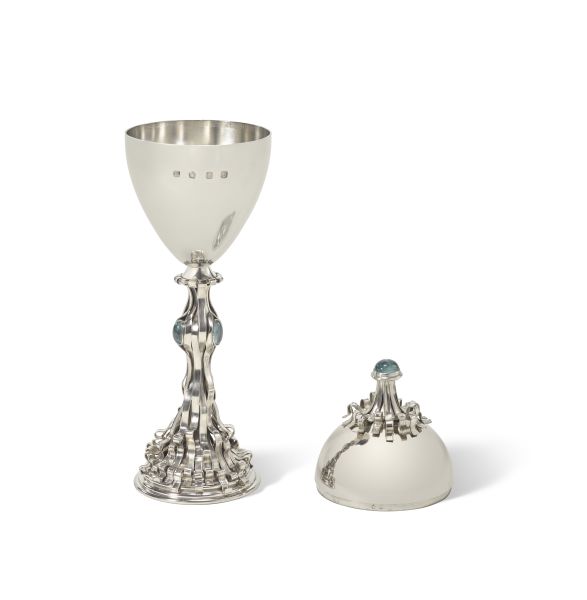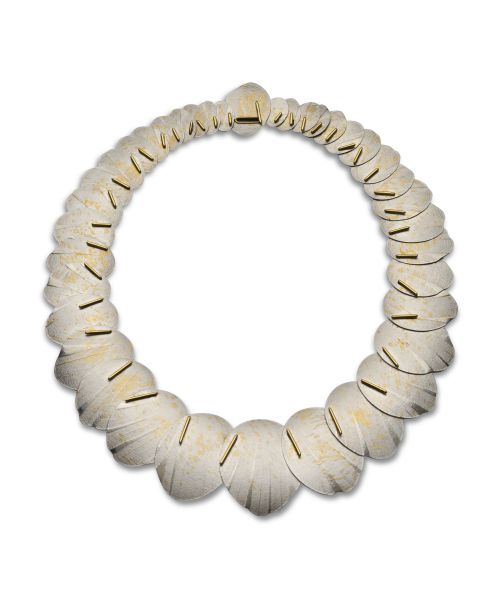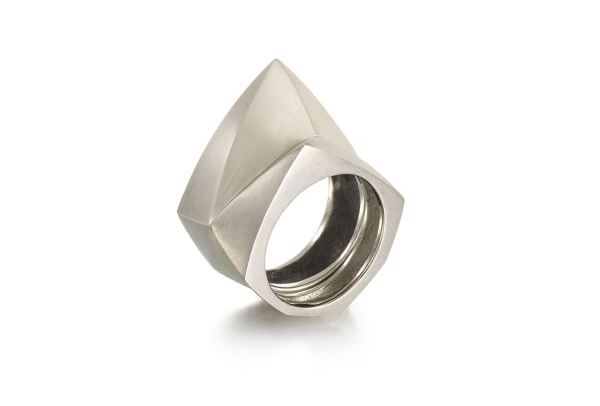‘Capable of great delicacy, elegance and preciousness…’ Platinum in the Goldsmiths’ Company Collection

Deputy Curator of the Goldsmiths’ Company, Dr Frances Parton, talks us through some of the landmark pieces that will be featured at Goldsmiths’ Fair’s Platinum exhibition.
Dr Frances Parton
The platinum hallmark was introduced in the UK on 2 January 1975. Jocelyn Burton (1946-2020), preeminent British designer-silversmith, was commissioned to produce a commemorative cup to mark the occasion by Rustenburg Mines, the largest producer of platinum at the time. The covered cup, designed by Burton and made in platinum by Hector Miller, was inspired by the form of a Renaissance period gourd-shaped standing cup, yet is arrestingly modern in its interpretation of a traditional form; a polished oval-shaped bowl sits on a stem decorated with contemporary strapwork which peels away from the surface like undulating strips of shredded paper. Four pale blue aquamarines set into the stem and the finial bring a delicate luminescence to the piece.
Marked in front of a large audience at Goldsmiths’ Hall, the cup was the first object in the UK to receive the new platinum mark, an orb within a pentagon, indicating that the fineness of the metal is at least 950 or 999 parts platinum per thousand. Burton describes her inspiration in designing such a significant piece in platinum as follows: ‘I have tried to show off the strength and flexibility of the metal in the whippy looking organic strapwork of the stem and, I hope, enhanced the natural greyness of platinum by the addition of South African aquamarines’. The cup, a landmark commemorative object in the history of platinum and of hallmarking, was presented to the Goldsmiths’ Company Collection by Rustenburg Mines.

The superlative British artist jeweller Jacqueline Mina OBE is renowned for her experimental approach to precious metals, creating sensuous gold jewels which combine technical innovation with a quiet, unassuming aesthetic sophistication. Mina has been at the forefront of technical experimentation with platinum since the early 1980s, combining it with gold in technically demanding ways with magnificent results. She won the Jerwood Prize for Applied Arts: Jewellery in 2000 for her ‘consistent innovation and significant contribution to contemporary jewellery … for subverting and taking precious metal techniques to the extreme’. The Company held a major retrospective of her work in 2011, the same year she was awarded an OBE and the Company Collection includes a wide range of her pioneering work in gold and platinum.
A necklace from 1984, made from overlapping oval-shaped platinum discs imprinted with textured paper and with gold flecks fused to their surface, represents another hallmarking landmark. The necklace bears the first ever hallmark for combined platinum and 18 carat gold; previously, precious metals were not allowed to be marked in combination. In Mina’s words; ‘I have worked in gold because its natural properties provide a constant source of inspiration, but I am always curious to discover what I could do with another metal, or another technique, … I have been able to discover for myself the platinum is not hard, cold or tough but that it is capable of great delicacy, elegance and preciousness, and that it is particularly effective when it is juxtaposed with yellow gold.’

One of the most recent acquisitions to the Company Collection, a pair of dramatic faceted rings by Melanie Eddy, celebrates both HRH the Queen’s Platinum Jubilee in 2022 as well as the distinctive qualities of platinum itself. Eddy’s mathematical jewellery exploits the use of geometry in the architecture of historic and contemporary sacred spaces to ‘foster a sense of solace, peace and spiritual experience’; she creates geometric jewellery as ‘intimate architecture – the design of structures for the body.’ The larger ring, made of silver, is sculptural and oversized, with bold architectural polished planes. It is designed to be worn stacked together with the narrower platinum ring, which is darker and more delicate with a dense opacity to its angled surfaces.
Eddy describes the way the two rings, when worn together, highlight the contrast between the two metals by reflecting light in strikingly different ways: ‘At first glance both silver and platinum appear silver in colour, but having two white metals that have different tones and reflective properties in the same set allow subtle discoveries as the rings play off of each other.’ Both rings bear the commemorative 2022 Jubilee hallmark.

